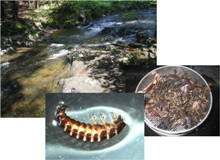ABSTRACTStudents will explore functional and taxonomic diversity in a stream ecosystem, learn about food web relationships, and learn about the ways in which abiotic and biotic factors determine what organisms are present in a community. Students will make and install artificial leaf packs in a stream, wait for the leaf packs to be colonized by stream organisms, measure abiotic variables that could influence leaf pack colonization, retrieve the leaf packs and classify the organisms they find in both taxonomic and functional ways, and participate in a class discussion of how the leaf pack community is situated within a larger ecosystem. AUTHORSJennifer H. Doherty1, Cornelia Harris2, Laurel Hartley3 1 - Department of Teacher Education, Michigan State University, East Lansing, MI 48824; dohertyjh@gmail.com 2 - Cary Institute of Ecosystem Studies, Education Department, PO Box AB, 2801 Sharon Turnpike, Millbrook, NY 12545-0178; harrisc@caryinstitute.org 3 - Department of Integrative Biology, University of Colorado Denver, Denver, CO 80217-3364; laurel.hartley@ucdenver.edu CLASS TIME1 session (30-45 minutes) to discuss the experiment and for students to formulate their research questions, 1 session (2-3 hours) to prepare and install leaf packs, 1 session (3-4 hours) to retrieve and identify organisms in leaf packs and begin data analysis. 1 optional session (20-30 minutes) for an instructor-led discussion of the conclusions students made based on their data. OUTSIDE OF CLASS TIME3-5 hours to finish data analysis and complete worksheets STUDENT PRODUCTS
SETTINGThis experiment was developed for use in a variety of stream systems that receive allochthonous inputs and has been tested in Santa Barbara, Denver, Baltimore, upstate New York and rural Michigan. Students will need to wade into streams to install artificial leaf packs that need to remain in the stream for 2-4 weeks, so we recommend that this activity not be conducted in larger, swift-moving streams. Students will need to bring leaf packs back to a laboratory classroom where access to dissecting microscopes would be advantageous. COURSE CONTEXTThis experiment has been used successfully in an introductory Ecology laboratory and in advanced high school Biology courses (8-24 students). This experiment would also be appropriate for introductory Biology laboratories. INSTITUTIONMedium-sized public university, public high schools TRANSFERABILITYThis experiment is transferable to non-majors courses and perhaps to upper division Ecology courses. A modified version of a longer, high school version (see acknowledgements) was used in a non-majors Environmental Issues class For example, analysis of data can range from displaying means (high school biology, non-majors undergraduate biology) to calculating richness indexes and conducting t-tests in Excel (majors biology, ecology). Experimental design support can range from little instructor support (ecology) to instructor’s providing examples or generating the questions (high school, non-majors). This experiment can be used in a variety of geographical regions as long as students have access to a stream in which aquatic invertebrates are living. DOWNLOADSDescription of other Resource Files:
ACKNOWLEDGMENTSA longer, high school version of this activity was developed as a teaching intervention to help students become more literate about biodiversity http://edr1.educ.msu.edu/EnvironmentalLit/publicsite/html/tm_be.html. This research is supported in part by a grant from the National Science Foundation: Targeted Partnership: Culturally relevant ecology, learning progressions and environmental literacy (NSF-0832173). Any opinions, findings, and conclusions or recommendations expressed in this material are those of the author(s) and do not necessarily reflect the views of the National Science Foundation. We acknowledge the researchers involved: Andy Anderson, Marcia Angle, Mitch Burke, Terry Grant, Michele Johnson, Shawna McMahon, John Moore, Liz Ratashak, Michael Schiebout, Jonathon Schramm, Scott Simon, Lori Spindler, and Brook Wilke. CITATIONJennifer H. Doherty, Cornelia Harris, and Laurel Hartley. 17 August 2011, posting date. Using Stream Leaf Packs to Explore Community Assembly Teaching Issues and Experiments in Ecology, Vol. 7: Experiment #3 [online]. http://tiee.esa.org/vol/v7/experiments/doherty/abstract.html |

This image shows a stream environment in upstate New York where we have tested this experiment, a sieve with leaves from a leaf pack, and a macroinvertebrate. Photo by Cornelia Harris. full size image |
<top> | |